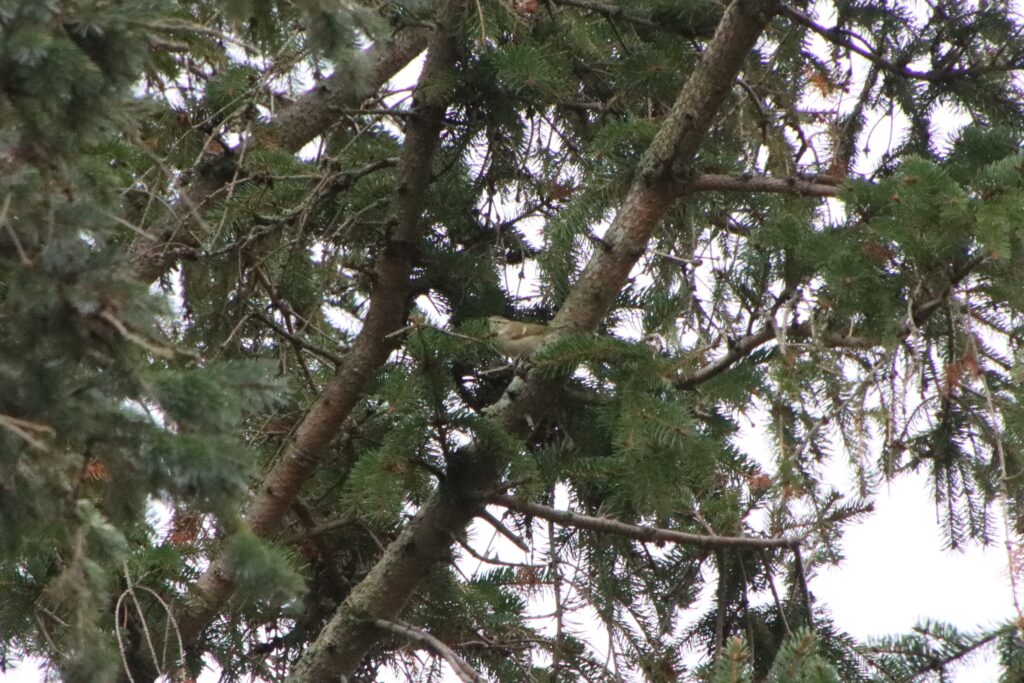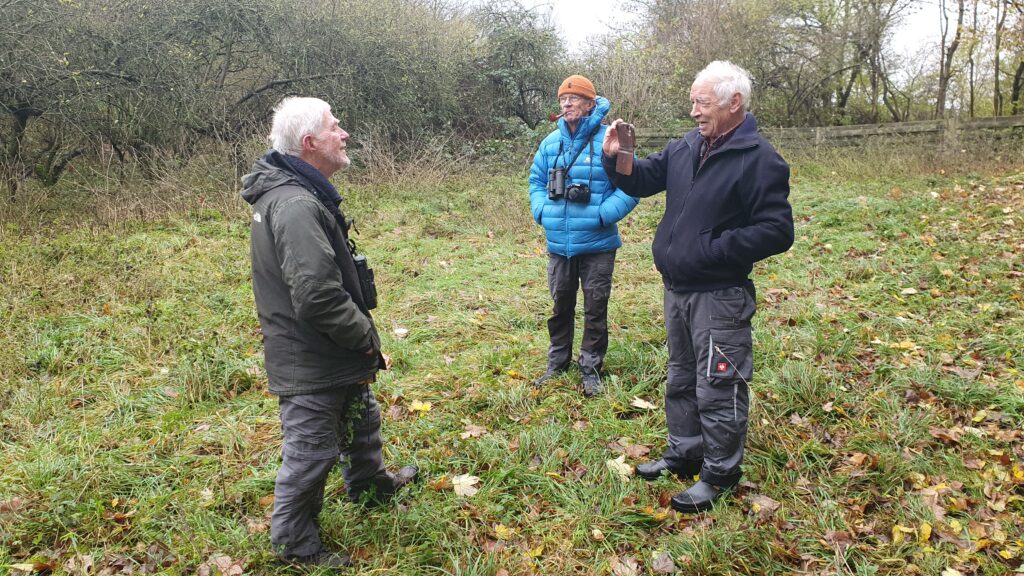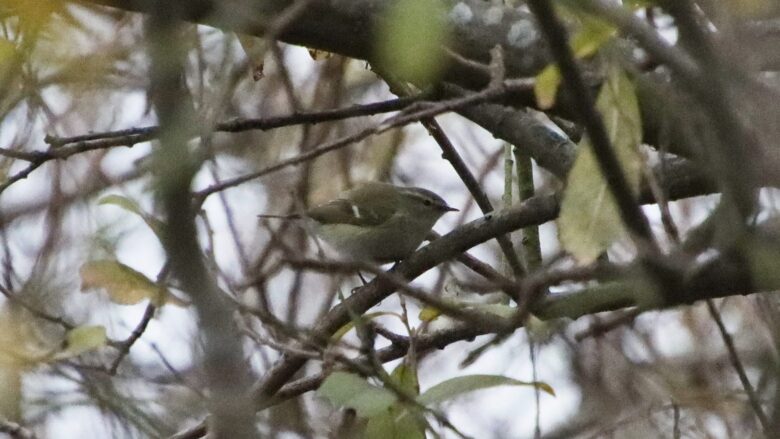This post is also available in: Dansk
Maybe, there was something
Actually, on Friday 2 December, the plan was for me to work in the garden – not to do bird ringing – but to prune some of the garden’s trees and bushes (which, by the way should improve the bird ringing). Bente was already at work in her home office when I decided to take a short trip out to Nyord – to see if there was anything.
It was cloudy and there was almost no wind. To the west, some rain showers were passing over Sjælland. I was standing in the bird tower at Nyord and checking the meadows. There were still quite a few Wigeons (Mareca penelope) present, some Teals (Anas crecca), and a single young White-tailed Eagle (Haliaeetus albicilla). In Ulvshale Løb there was a flock of Pintails (Anas acuta) – a few hundred. But otherwise, not that much and I decided to move on.
In the car, I remembered that the other day a Siberian Thrush (Geokichla sibirica) had been seen somewhere in the Netherlands. Maybe I should do a round at Nyord Kirkegård and check if any rare thrush had dropped in. In this case Nyord Kirkegård actually means the small grove that lies immediately adjacent to the cemetery itself. The grove is always worth checking – especially for passerines, but I’d be surprised if I actually found a rare thrush. Thrushes like apples – and in the grove, there are often blackbirds (Turdus merula) and other thrushes that forage on fallen apples – so why not?
Hume’s Warbler!
I was on the north side of the grove, and as so many times before, I had did a short walk on the track towards the north meadow. From there you can check the northwest corner of the meadows. This yielded two Ravens (Corvus corax) and a pair of Whooper Swans (Cygnus cygnus) flying over.
About 9:30 I’m about to walk back to the grove, when suddenly I hear a single bird call further away! Something like tiwiid (it’s not easy to spell bird calls). “Hume’s Warbler”! was my spontaneous reaction, followed by a “no, it can’t be right”?
Or could it? I did only hear it once and not very loud. But it sounded very much like a Hume’s Warbler (Phyllosscopus humei), and not like some of our common birds. I stood still and listened, but it was very quiet, except for some Greylag Geese (Anser anser) farther away.
Hume’s Warbler is a fairly rare bird in Denmark, but during October and November, there had been a small influx of the species (approx. 6 – 7 individuals) in various places in the country. And as recently as the week before, Bente and I saw and heard one at Lille Vejlesø in Køge Bugt Beach Park (we were not the ones who found that individual). In other words, it was not entirely improbable – and I had the call fresh in my memory. But doubts still arose because I had only heard one distant call – was it a mis-hearing? There was only one thing to do, and that was quickly get to where I thought the call must have come from.

It is good!
Soon after, I was quietly moving along the footpath through the northern edge of the grove. I stopped in a few places and listened – but there was nothing to hear. Suddenly I heard the call again – loud and clear, and right above my head! The same tiwiid as earlier.
This time the bird is calling 3-4 times. My doubt has gone – it is Hume’s Warbler. I look up and almost immediately see a small greyish bird that moves quickly, almost jerkily, around in the trees approx. 3 – 4 meters up. I can’t see much, but it looks like a little warbler with a distinct supercilium. I’m trying to take some photos for documentation (at 08:35), which I wasn’t sure was successful. The bird is not very cooperative and does not perch for long. After that, I get my mobile phone out of my pocket – ready to record the call – when and if the warbler will call again. Fortunately, it does and I succeed in getting a recording (at 09:37). Now I note that it is now approx. seven minutes since I first heard the call! You can hear the recording below.
Announcement of the bird
Now the bird must be reported, so that other birders will have the opportunity to get it – if it sticks around long enough.
The bird is silent and I hasten to send the message “HIMALAYASANGER nyord kirkegård” to Bente via WhatsApp (at 09:39), knowing that she is working and is not able to twitch the bird. She replies ten minutes later with the messages “Cool” and “They are apparently quite common” – referring to our observation last week.
Having sent the message to Bente, I call Per Schiermacker-Hansen (PSH) as the first person. I assume he is somewhere in Østmøn, and will therefore need more time to get to Nyord. No immediate response so I hang up. I’m just about to call Ole Lund Jensen (OLUJ) when PSH calls back (at 09:40). I tell him that I have a Hume’s Warbler and a very brief report. He will drive towards Nyord immediately. The call lasts 29 seconds.
Then I announce it on BirdAlarm as Hume’s Warbler with the text “Nyord Kirkegård, the bird seen (relatively high), heard calling several times (recorded), but otherwise silent” (at 09:40)”.

I considered whether I should announce it on the Zello channel Birding Møn (Zello is a walkie-talkie app), but initially chose not to (although I am actually “trained” in radio communication – but that’s a completely different story ).
The bird is quiet and I only see 3-4 kinglets in the trees above me. Now I call OLUJ (at 09:43), who lives at Ulvshale not far away, and tell him about the bird. That call takes 45 seconds. Now I will concentrate on the warbler.
The article continues below this Advertisement
The first local birder arrives
After a few minutes the bird starts calling again, but only a few series of 2-3 calls. That’s enough for me to locate it. It is now on the other side of the footpath – in a thicket towards the meadows. It still moves in short, quick jerks, but I manage to see at least one wing band. After a while I lose sight of it. However, I see many other wingbands – unfortunately they all belong to the kinglets that forage around me.
So far I have been alone in the grove. I have spent the time trying to keep track of the bird – I know that PSH and OLUJ are on their way, and probably others too. At the same time, I tried to see as many details as possible. I see long light, whitish supercilium, dark eye stripe, and a distinct wing band on the greater coverts – and I also think I see a hint of a smaller wing band on the median coverts. I record a few small video clips to document the habitat while the bird can be heard calling. At 10:04 OLUJ silently arrives. I quickly pinpoint the area where I last heard the warbler and give him a quick update on the situation.
It doesn’t take long before the bird calls again. Fortunately, we see some movement in the thicket, which turns out to be the Hume’s Warbler. It has moved down and is suddenly perched in front of us on a branch approximately one meter above the ground – only at a distance of 6-8 m! Ole exclaims – “The supercilium almost reaches the back of its neck”! We both manage to see the bird reasonably well before it disappears further into the thicket.

More birders hear and see the bird
PSH arrives and is updated on the situation. The bird calls close to where we are. A little later, PSH calls Niels Peter Andreasen (NPA) – who is not on BirdAlarm or other bird reporting systems. The next one to appear is Bo Kayser (BK) and it doesn’t take long before he also hears the Hume’s Warbler.
Bo – who actually had another errand – says that this is the first time he has driven a “detour” of five kilometers to see a rare bird. There is a bit of a laugh about it and we agree that he can now call himself a twitcher.
During the morning, the Hume’s Warbler moves away from the edge of the forest and further into the area. At some point it has apparently moved all the way over to the tall old fir trees in the center of the area. It seemed that the warbler was responding to the increasing – and cold – wind from a northeasterly direction and sought shelter. We did that too.
Meanwhile, NPA has arrived and he manages to hear the bird calling a few times.
No one had heard the bird for a while when Leif Schack-Nielsen (LSN) arrived at the site. Together with LSN, we were now six birders, listening and looking for the rare warbler in different parts of the grove – unfortunately without success. I might have heard it distantly once, but wasn’t sure.
At the end of the morning, the bird had been silent for a long time. Fortunately, later in the day – around 3 pm – it was found again by Niels Bahl Andersen (NBA). He heard it by the fir trees, where we had lost it

Recordings for TV Møn
As a small curiosity, during the morning Sigurd from TV Møn appeared quite by chance. Unfortunately, there were no signs of Hume’s Warbler – it was silent. Sigurd became very interested when he heard what was going on. The result was that PSH, NPA, and I were taking part in some spontaneous TV recordings, where we told a bit about the discovery and warbler. At this point, I haven’t seen if anything useful actually came out of the recordings. I myself did not have the feeling that it would be my “TV breakthrough” and I stated to the others that “it was probably a good thing that it was not a national TV channel”!

Approval from the Rarities Committee is now awaited
For the following four days, I visited the Nyord Kirkegård every day, from the morning until just before lunch. The Hume’s Warbler was still around – sometimes more active than at other times. I got recordings of its calls every day and also managed to get a few photos as documentation – but not any in award-winning quality.
Most of the local birders were present at Nyord Kirkegår at some point and got the bird. So were several visiting birdwatchers. Many did not only hear the bird but also managed to catch a glimpse of it.
Read also about our twitch of the White-winged Tern on Öland in Phalaropes, White-winged Black Tern, and a failed harbor project on Öland
However, we had to return to Copenhagen on Tuesday afternoon, and I left the job of following the warbler’s stay at Nyord to the local birders – and others who happened to pass by. At home, my job, on the other hand, was to make a description for SU.
Hume’s Warbler is on the Danish SU list (list of rare birds), which means that the occurrence of the species in Denmark is so rare that it requires documentation before the record can be published in publications from BirdLife Denmark (DOF). It is the Rarities Committee (SU) in DOF that decides whether the documentation is sufficient for the record to be accepted (read more about SU here). So far, there are 49 accepted records of Hume’s Warbler from Denmark. There is one from Møn (a bird found by Anders Prehn in 2003) and thus the bird I found is only the second occurrence of the species at Møn.
Back in Copenhagen, I made a description of my experiences and of the bird, I listened through my audio recordings, and went through blurred photos, to see if any could be used. The SU description is finished – and now I hope that it will be accepted by SU.
At the time of writing, the Himalayan warbler is still in place at Nyord Kirkegård (Monday 12 December).
All photos, video and sound recordings © Bente Steffensen & Uffe Damm Andersen unless otherwise stated.
The article continues below this Advertisement

